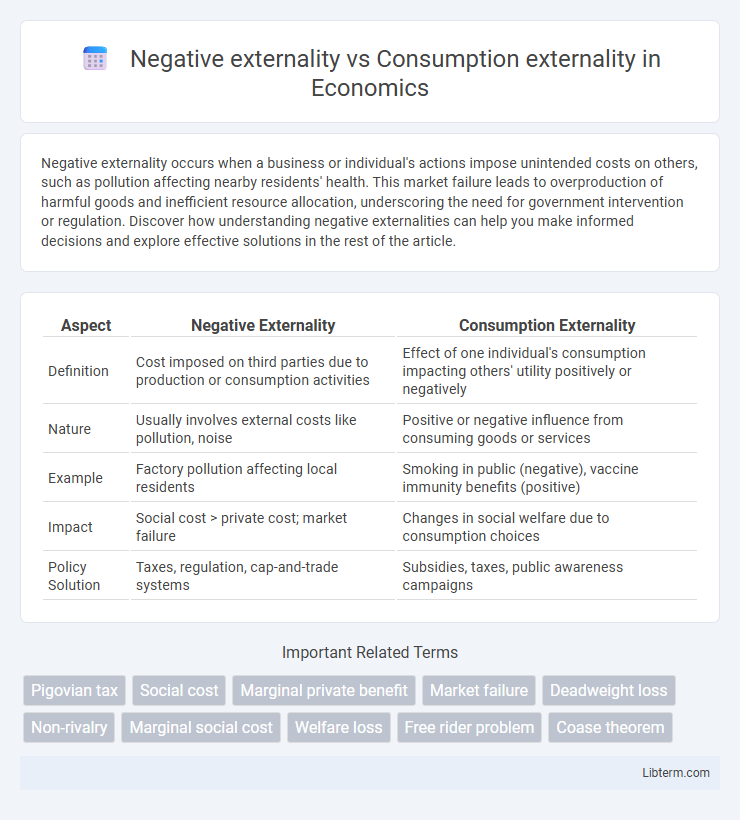Negative externality occurs when a business or individual's actions impose unintended costs on others, such as pollution affecting nearby residents' health. This market failure leads to overproduction of harmful goods and inefficient resource allocation, underscoring the need for government intervention or regulation. Discover how understanding negative externalities can help you make informed decisions and explore effective solutions in the rest of the article.
Table of Comparison
| Aspect | Negative Externality | Consumption Externality |
|---|---|---|
| Definition | Cost imposed on third parties due to production or consumption activities | Effect of one individual's consumption impacting others' utility positively or negatively |
| Nature | Usually involves external costs like pollution, noise | Positive or negative influence from consuming goods or services |
| Example | Factory pollution affecting local residents | Smoking in public (negative), vaccine immunity benefits (positive) |
| Impact | Social cost > private cost; market failure | Changes in social welfare due to consumption choices |
| Policy Solution | Taxes, regulation, cap-and-trade systems | Subsidies, taxes, public awareness campaigns |
Introduction to Externalities
Negative externalities occur when the production or consumption of a good or service imposes unintended costs on third parties, such as pollution from factories affecting nearby residents. Consumption externalities specifically refer to external effects generated by the consumption activities of individuals, like secondhand smoke harming non-smokers. Understanding these externalities is crucial for designing policies that internalize social costs and promote efficient market outcomes.
Defining Negative Externality
A negative externality occurs when a transaction or activity imposes unintended costs on third parties who are not involved in the decision-making process, such as pollution from factories affecting nearby residents. Consumption externalities arise when the consumption of a good or service affects others' well-being, either positively or negatively, without compensation or consent. Both concepts highlight market failures where private costs or benefits diverge from social costs or benefits, requiring interventions to align individual incentives with societal welfare.
Understanding Consumption Externality
Consumption externality occurs when the consumption of a good or service by one individual affects the well-being of others, either positively or negatively, without compensation. Unlike negative externalities that typically refer to production harms such as pollution, consumption externalities are driven by personal usage behaviors influencing third parties, like secondhand smoke causing health issues. Understanding consumption externality is crucial for designing policies such as taxes or subsidies that correct market failures and promote socially optimal consumption levels.
Key Differences Between Negative and Consumption Externalities
Negative externalities occur when the cost of a good or service is imposed on third parties, leading to social inefficiency, such as pollution from factories affecting nearby residents. Consumption externalities specifically arise from the consumption of goods or services that impact others, either positively (vaccinations reducing disease spread) or negatively (secondhand smoke harming bystanders). The key difference lies in the source: negative externalities primarily involve production external costs, while consumption externalities stem directly from consumer behavior and its impact on third parties.
Real-world Examples of Negative Externalities
Negative externalities occur when a third party suffers costs due to an economic activity, such as air pollution from factories harming nearby residents' health. Consumption externalities arise when the consumption of a good affects others, exemplified by secondhand smoke impacting non-smokers. Real-world examples of negative externalities include traffic congestion causing increased travel times and pollution, and industrial waste contaminating water sources used by communities.
Real-world Examples of Consumption Externalities
Consumption externalities occur when an individual's consumption affects the well-being of others, either positively or negatively, without compensation. Real-world examples include secondhand smoke from cigarettes harming non-smokers and loud music disturbing neighbors, illustrating negative consumption externalities. Positive consumption externalities can be seen in education, where an individual's learning benefits society by fostering a more informed and productive community.
Economic Impact of Negative versus Consumption Externalities
Negative externalities impose costs on third parties, leading to market inefficiencies by causing overproduction and social welfare loss, exemplified by pollution from industrial activities. Consumption externalities affect individuals' well-being beyond the consumer, such as secondhand smoke negatively impacting non-smokers, altering demand patterns and potentially requiring corrective policies. The economic impact differs as negative externalities often trigger regulatory interventions and increased social costs, while consumption externalities influence consumption behavior and public health, affecting resource allocation and societal outcomes.
Policy Responses and Regulation
Negative externalities often require government intervention through corrective taxes, subsidies, or regulations to internalize social costs and reduce harmful effects such as pollution or resource depletion. Consumption externalities, where individual consumption imposes costs or benefits on others, may be addressed by policies like Pigouvian taxes, public awareness campaigns, or consumption taxes to align private incentives with social welfare. Effective regulation balances economic efficiency with social equity by targeting the source of externalities and ensuring compliance through monitoring and enforcement mechanisms.
Challenges in Addressing Externalities
Negative externalities, such as pollution or noise, create social costs that are not reflected in market prices, leading to overconsumption and welfare losses. Consumption externalities arise when an individual's consumption affects others' well-being positively or negatively, complicating demand and supply assessments. Addressing these externalities faces challenges including accurate measurement of external costs or benefits, enforcement of regulations, and designing effective policies that balance economic efficiency with equity concerns.
Conclusion: The Importance of Differentiating Externality Types
Differentiating between negative externalities and consumption externalities is crucial for effective policy-making and resource allocation. Negative externalities typically involve unintended social costs from production or consumption, such as pollution, while consumption externalities specifically arise when the consumption of goods affects third parties, like secondhand smoke. Clear identification ensures targeted interventions, minimizes welfare losses, and promotes economic efficiency.
Negative externality Infographic

 libterm.com
libterm.com